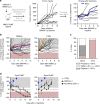TGFβ blocks IFNα/β release and tumor rejection in spontaneous mammary tumors
- PMID: 31511510
- PMCID: PMC6739328
- DOI: 10.1038/s41467-019-11998-w
TGFβ blocks IFNα/β release and tumor rejection in spontaneous mammary tumors
Abstract
Type I interferons (IFN) are being rediscovered as potent anti-tumoral agents. Activation of the STimulator of INterferon Genes (STING) by DMXAA (5,6-dimethylxanthenone-4-acetic acid) can induce strong production of IFNα/β and rejection of transplanted primary tumors. In the present study, we address whether targeting STING with DMXAA also leads to the regression of spontaneous MMTV-PyMT mammary tumors. We show that these tumors are refractory to DMXAA-induced regression. This is due to a blockade in the phosphorylation of IRF3 and the ensuing IFNα/β production. Mechanistically, we identify TGFβ, which is abundant in spontaneous tumors, as a key molecule limiting this IFN-induced tumor regression by DMXAA. Finally, blocking TGFβ restores the production of IFNα by activated MHCII+ tumor-associated macrophages, and enables tumor regression induced by STING activation. On the basis of these findings, we propose that type I IFN-dependent cancer therapies could be greatly improved by combinations including the blockade of TGFβ.
Conflict of interest statement
The authors declare no competing interests.
Figures






Similar articles
-
Mouse, but not human STING, binds and signals in response to the vascular disrupting agent 5,6-dimethylxanthenone-4-acetic acid.J Immunol. 2013 May 15;190(10):5216-25. doi: 10.4049/jimmunol.1300097. Epub 2013 Apr 12. J Immunol. 2013. PMID: 23585680 Free PMC article.
-
5,6-Dimethylxanthenone-4-acetic acid (DMXAA) activates stimulator of interferon gene (STING)-dependent innate immune pathways and is regulated by mitochondrial membrane potential.J Biol Chem. 2012 Nov 16;287(47):39776-88. doi: 10.1074/jbc.M112.382986. Epub 2012 Oct 1. J Biol Chem. 2012. PMID: 23027866 Free PMC article.
-
Induction of STAT and NFkappaB activation by the antitumor agents 5,6-dimethylxanthenone-4-acetic acid and flavone acetic acid in a murine macrophage cell line.Biochem Pharmacol. 1999 Oct 1;58(7):1173-81. doi: 10.1016/s0006-2952(99)00194-x. Biochem Pharmacol. 1999. PMID: 10484075
-
Innate Antiviral Defenses Independent of Inducible IFNα/β Production.Trends Immunol. 2016 Sep;37(9):588-596. doi: 10.1016/j.it.2016.06.003. Epub 2016 Jun 23. Trends Immunol. 2016. PMID: 27345728 Review.
-
5,6-dimethylxanthenone-4-acetic acid (DMXAA): a new biological response modifier for cancer therapy.Invest New Drugs. 2002 Aug;20(3):281-95. doi: 10.1023/a:1016215015530. Invest New Drugs. 2002. PMID: 12201491 Review.
Cited by
-
The Remarkable Plasticity of Macrophages: A Chance to Fight Cancer.Front Immunol. 2019 Jul 12;10:1563. doi: 10.3389/fimmu.2019.01563. eCollection 2019. Front Immunol. 2019. PMID: 31354719 Free PMC article. Review.
-
High TGF-β signature predicts immunotherapy resistance in gynecologic cancer patients treated with immune checkpoint inhibition.NPJ Precis Oncol. 2021 Dec 17;5(1):101. doi: 10.1038/s41698-021-00242-8. NPJ Precis Oncol. 2021. PMID: 34921236 Free PMC article.
-
RGD-binding integrins and TGF-β in SARS-CoV-2 infections - novel targets to treat COVID-19 patients?Clin Transl Immunology. 2021 Mar 18;10(3):e1240. doi: 10.1002/cti2.1240. eCollection 2021. Clin Transl Immunology. 2021. PMID: 33747508 Free PMC article. Review.
-
A distinct circular DNA profile intersects with proteome changes in the genotoxic stress-related hSOD1G93A model of ALS.Cell Biosci. 2023 Sep 13;13(1):170. doi: 10.1186/s13578-023-01116-1. Cell Biosci. 2023. PMID: 37705092 Free PMC article.
-
Anti-triple-negative breast cancer metastasis efficacy and molecular mechanism of the STING agonist for innate immune pathway.Ann Med. 2023 Dec;55(1):2210845. doi: 10.1080/07853890.2023.2210845. Ann Med. 2023. PMID: 37162544 Free PMC article.
References
Publication types
MeSH terms
Substances
LinkOut - more resources
Full Text Sources
Molecular Biology Databases
Research Materials

